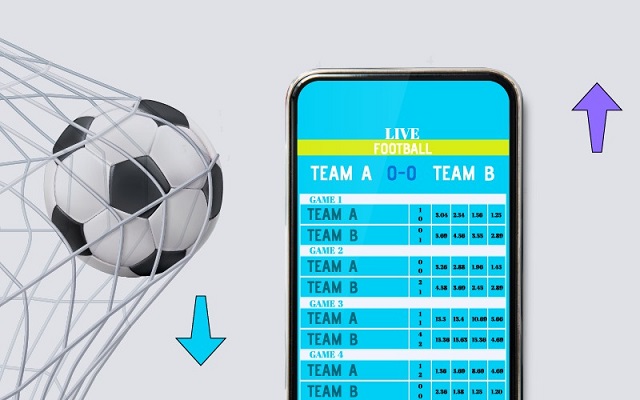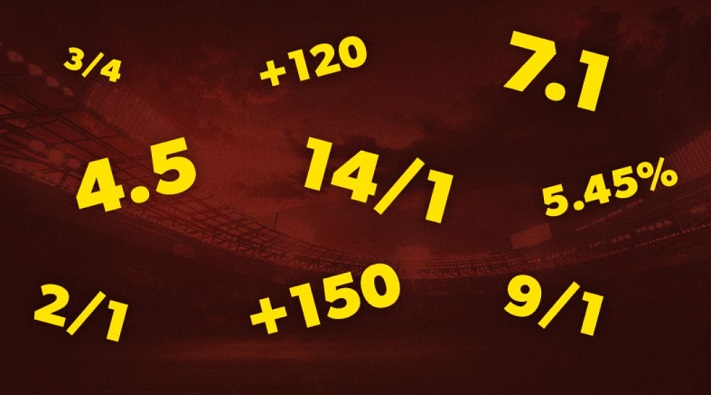|
Listen to this article
|
Understanding and interpreting odds is crucial for making informed betting decisions. The odds provided by bookmakers reflect their assessment of the likelihood of various outcomes. Different bookmakers may offer slightly different odds, so it’s often a good idea to shop around for the best value if you’re considering placing a bet. If you want to up your income from betting, you need to use 4 Ra Bet Bonuses!
Betting odds represent the probability of a particular outcome in a sporting event or any other type of bet. Odds are typically expressed in three formats: fractional odds, decimal odds, and moneyline odds. Here’s a brief explanation of each:
Betting Odds Meaning
“Betting odds” refer to the numerical representation of the likelihood of a particular outcome occurring in a betting event. These odds are set by bookmakers or sportsbooks and serve as a way to express the potential returns on a bet.

The odds indicate both the probability perceived by the bookmaker and the potential payout for the bettor.
Betting odds are numerical representations of the likelihood of a particular outcome in a betting event or sports event. They are used to calculate potential payouts to bettors and help determine the implied probability of an outcome. Betting odds are typically expressed in three main formats: fractional odds, decimal odds, and moneyline odds. Here’s a brief explanation of each:
- Fractional Odds: Fractional odds, also known as British odds, are presented as a fraction, such as 2/1 or 5/2. The first number (numerator) represents the potential profit, while the second number (denominator) represents the amount you need to wager. So, for 2/1 odds, if you bet $1, you could potentially win $2 in profit, plus your original $1 stake.
- Decimal Odds: Decimal odds, also known as European odds, are presented as a decimal number, such as 3.00 or 2.50. To calculate potential winnings, you simply multiply your stake by the decimal odds. For example, if you bet $100 on odds of 2.50, you could potentially win $250 (including your original $100 stake).
- Moneyline Odds: Moneyline odds are primarily used in the United States and are represented as either positive (+) or negative (-) numbers. Positive moneyline odds (e.g., +200) indicate the potential profit on a $100 bet, while negative moneyline odds (e.g., -150) indicate how much you need to wager to win $100. For example, if you see +200, a $100 bet would potentially yield $200 in profit if successful. If you see -150, you would need to bet $150 to potentially win $100 in profit.
The odds reflect the bookmaker’s assessment of the probability of a particular outcome occurring. Shorter odds (e.g., 1/1 or 2.00) imply a higher likelihood of the event happening, but lower potential profits. Longer odds (e.g., 5/1 or 6.00) suggest a lower probability but higher potential profits if the event occurs.

It’s important to understand how to read and interpret odds to make informed betting decisions. Different bookmakers and regions may use different formats, so familiarizing yourself with all three types of odds can be useful for understanding the betting landscape. Additionally, understanding implied probabilities (the likelihood of an outcome as implied by the odds) is crucial for assessing whether a bet offers value.
How It Works
Here’s a general overview of how betting odds work:
- Probability: Bookmakers assess the probability of different outcomes in a given event. The odds represent this probability and are often expressed as a fraction, decimal, or moneyline.
- Understanding Payouts: The odds reflect the bookmaker’s assessment of the likelihood of an outcome. Lower odds imply a higher probability of the event occurring but a smaller potential payout. Higher odds suggest a lower perceived probability but a larger potential payout.
- Calculating Payouts: To calculate potential payouts, multiply your stake by the odds. Each type of odds has a different formula, we will explain that in the next steps.
- Comparison and Shopping for Odds: Different bookmakers may offer slightly different odds for the same event. Bettors often compare odds from various sources to find the best value and potential returns for their bets.
Understanding how odds work is crucial for bettors to make informed decisions and assess the risk and potential reward associated with different bets.
How The Bookmaker Set The Betting Odds
Every day, bookmakers offer thousands of outcomes. The probability of outcomes can change many times: when the composition of the team changes, the weather changes, one of the players drops out or is replaced by another, and the coach changes.

Naturally, the bookmaker cannot monitor every change in every match. Instead, this is done by special operators: sports data providers. There are several large companies in the world: Gracenote, Sportradar, SportScore, BetRadar, GeniusSports, and BetFair. They collect data from various sources in real-time and sell it to bookmakers. Based on this data, the bookmaker can set its odds.
Why The Odds Are Change Time-by-Time
The same bet can have different odds at different times. Typically, rapid and dramatic changes occur once a sporting event has already begun. The odds of a bet change depending on how it pans out.
For example, there is a football match going on, and initially, the bookmaker offers to bet on the number of corners greater than 9 with odds of 1.5. But both teams shot at goal very often, which is why in the first half the number of corners reached 7. In this case, the coefficient of this bet will decrease: for example, to 1.05. Because there is a very high probability that in the next 45 minutes, the teams will earn 2 more corners.
Also, the odds may change before the event starts. Especially if the bookmaker offered the bet long ago: for example, a month before the match. During this month, a lot can change in the composition of the teams: a player may get injured, be disqualified, or he may be replaced. In such cases, the betting odds will also change.
For the bettor, the odds are fixed at the moment he confirms the bet. That is, if you bet $10 on KKR winning cricket in the IPL 2024 with odds of 2.2 today, then this chance will be fixed. Even if in a week it increases or decreases, it will remain at 2.2 in your bet. New odds will only be relevant for other bettors. Or for you if you cancel the previous bet and place it again.
Explained How To Understand The Bet Win Chance By Odds
The explanation is simple: the higher the bet odds, the less likely this outcome is. This means there is a lower chance that this bet will win.

For example: in a football match between Arsenal and Nottingham Forrest, Arsenal are considered the favourites. This means that the chances of him winning will be higher, and the betting odds will be lower: about 1.2-1.4. And vice versa: Nottingham Forrest is considered an outsider in this meeting. Therefore, his chances of winning are lower, and the coefficient is higher: about 1.7-2.0.
We conclude: that the higher the bookmaker’s odds on the outcome, the lower the likelihood that he will win. Therefore, bets with high odds must be placed very carefully. Before doing this, you need to conduct an in-depth analysis to be sure that the risk is justified.
How To Calculate The Different Types Of Odds
As we told the top, there are a few different types of odds. Here is the table with the difference between Fractionals, Decimals, Asian, and American types of the odds with calculating examples to each:
| Odds Type | Format, Example | Calculation | Example Of Calculating |
| Decimal Odds | 1,27, 2.50, 3.00 | Potential winnings = Bet amount x Decimal odds | $100 bet at 3.00 odds = $300 |
| American Odds | +150, -200 | Positive odds: Potential profit on $100 bet | +150 means $100 bet = $150 profit |
| Negative odds: Amount needed to win $100 | -200 means $200 bet to win $100 | ||
| Fractional Odds | 2/1, 5/2 | Potential profit = (Stake x Numerator) / Denominator | $100 bet at 2/1 odds = $200 profit |
| Asian Odds | -1.5, +0.5 |
Usually, you can find the American type of odds in the US bookmakers and in Indonesia. The Decimals are the most popular among European bookies, but also you can find them in Canada and Australia. Asian type is supported by Asian Bookmakers, but it is the most popular in football betting. The Fractional odds you can find in Europe.
Conclusion
Betting odds are numerical representations of the likelihood of a particular outcome occurring in a betting event. Bookmakers assign odds to various outcomes based on statistical analysis, historical data, and market trends.

The three main types of odds are Decimal, American (or moneyline), and Fractional. Decimal odds express the potential total returns for a bet, with the original stake included in the calculation. American odds use positive and negative numbers to indicate the potential profit or the amount needed to win $100, distinguishing between favorites (negative odds) and underdogs (positive odds). Fractional odds, presented as a fraction, denote the potential profit relative to the stake.
To read odds, one must understand that lower odds imply a higher probability of the event occurring but yield a smaller potential payout. Higher odds suggest a lower perceived probability but come with a larger potential payout. Implied probability can be derived from odds, aiding bettors in assessing the likelihood of an outcome. Additionally, recognizing the favorite and underdog is crucial in moneyline odds, where negative numbers represent favorites, and positive numbers denote underdogs. Comparing odds from different bookmakers helps bettors find the best value for their wagers.
Betting Odds Explained Video
FAQ
Why Do I Need To Understand The Betting Odds Meaning?
The odds are the basic parameter in the formula, which calculates the chances for a win and the payout.
Why Do Different Bookmakers Have Different Odds?
The odds for the same stake can be different in different bookies. The reason is next: that bookies can get the data from different sporting operators. Also, the bookies can use different formulas to make their marge.
How Does Betting Odds Work?
Lower odds suggest a higher likelihood of the event occurring but come with smaller potential payouts, while higher odds indicate a lower perceived probability but offer larger potential winnings.
How To Calculate Betting Odds?
Decimal Odds: Potential Winnings = Bet Amount × Decimal Odds
American (Moneyline) Odds: Positive Odds: Potential Profit = (Bet Amount / 100) × Odds. And for Negative Odds: The bet Amount needed to win $100 = (100 / Absolute Value of Odds)
Fractional Odds: Potential Profit = (Stake × Numerator) / Denominator
How To Read Betting Odds?
Betting odds indicate the potential payout and implied probability of a particular outcome in a betting event, with lower odds suggesting higher probability but smaller potential winnings, and higher odds suggesting lower probability but larger potential returns.
Where do The Bookies Get The Odds?
From sports data providers. These are the companies that specialize in searching and accumulating of data about sports: players’ physical and mental health, team players lists, and coaches. And with that information, the operators make the predictions.

Satish, a prolific author hailing from India, has become a prominent figure in the world of online sports betting. With a deep passion for both sports and data analysis, he has carved out a niche for himself as a trusted source of information and insights in the ever-evolving landscape of sports betting.
Satish’s articles are known for their in-depth analysis, statistical rigor, and keen eye for emerging trends, making him a sought-after authority in the field. His work not only informs but also empowers sports enthusiasts and bettors, providing them with valuable knowledge to make informed decisions in the world of online sports wagering.
